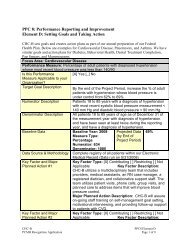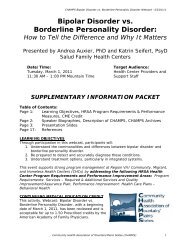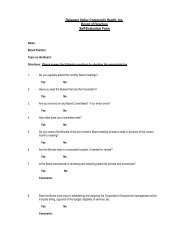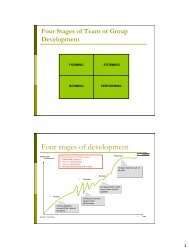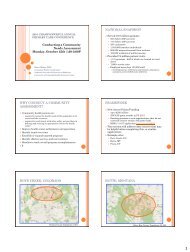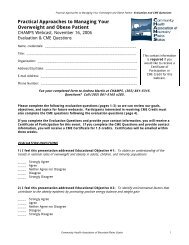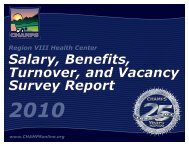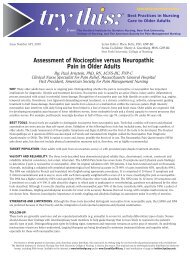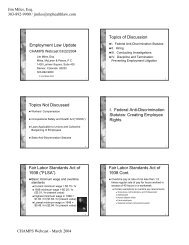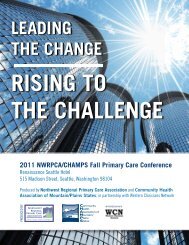Quality Plan Assessment Tool - KAMU
Quality Plan Assessment Tool - KAMU
Quality Plan Assessment Tool - KAMU
- No tags were found...
Create successful ePaper yourself
Turn your PDF publications into a flip-book with our unique Google optimized e-Paper software.
IPTV: Broadband meets broadcastThis influential independent reportpresents the key issues that everysenior executive and decision makerinvolved in media and communicationsneeds to know and understand aboutthe future of television.Drawing on decades of combined experience,extensive interviews and the latest available industryresearch, this concise executive report providesan authoritative overview of the emerging marketfor delivering audio and video services over datanetworks.The convergence of broadband and broadcast deliverywill inevitably disrupt existing telecommunicationsand television industries as they collide and collapseconventional boundaries.The network television revolution will changechannels of distribution and fundamentally affect theway television is viewed in the future.Billions are being bet on the outcome that couldradically transform the media landscape forever.Multichannel television of a few hundred linearchannels will soon seem archaic. Viewers willeventually be able to choose from thousands ofprogrammes and channels from around the world,much as it is already possible to stream radioservices today. The network will in effect become anindefinitely expandable personal video recorder.This presents many threats and opportunities to theexisting broadcasting industry and represents a realrevolution in digital television.In response to recent unprecedented global interest,informitv and Lovelace Consulting have produced thisexclusive executive briefing that explains the keyissues in simple terms that cut through the hyperboleand jargon to provide a clear picture of the nextrevolution in communications.With an independent perspective, based on practicalprofessional experience, this report places thesedevelopments in context to empower decision makersto formulate their own strategy in response to thesignificant threats and opportunities presented.RelevanceThis briefing is recommended reading for all boarddirectors, senior executives, heads of departmentsand other senior managers with responsibility forcommissioning, producing, creating, scheduling,promoting, marketing or distributing audio andvideo material or services.The report is also very relevant to anyone involvedin the telecommunications, media and technologyecosystem:• Broadcasters and platform operatorsUnderstand the impact of new modes ofdistribution on existing businesses.• Telecommunications companiesAppreciate the challenging issues involved in theprovision of video services directly to consumers.• Broadband service providersIdentify new opportunities to offer value-addedcontent and applications.• Content producers and aggregatorsExploit valuable new revenue streams whileavoiding problems with piracy.• Brand owners and rights holdersAnticipate new business models in this rapidlyevolving environment.• Advertisers and sponsorsRecognise the impact on traditional advertising anddevelop new business models.• Technology providers and integratorsRealise the market opportunity for new productsand services.• Marketing and public relations advisersEstablish the broader business context for yourclients.• Academics, lawyers and regulatorsAddress the effects on competition and copyrightlaw and regulatory frameworks.• Consultants, investors and analystsAssess the commercial prospects for the nextgeneration of video, voice and data services.iptv-report.com
3ONLY for distribution to FQHCs without cost by any consultant or PCAObjectives for This <strong>Tool</strong>: Provide a tool health centers can use to assess the organization’s current <strong>Quality</strong> Improvement (QI) <strong>Plan</strong>; Equip health center staff to develop/ revise the <strong>Quality</strong> <strong>Plan</strong> with a format and content that will meet HRSA andaccreditation expectations; Offer practical advice on developing and implementing a <strong>Quality</strong> <strong>Plan</strong> that meets organizational needs and supports theorganization rather than being an encumbrance; and Inform health center staff of other resources available to assist in their quality improvement efforts<strong>Quality</strong> <strong>Assessment</strong><strong>Quality</strong> assessment is a component of continuous quality improvement. <strong>Quality</strong> assessment is a systematic, ongoing cycle ofcollecting and analyzing evidence of a program's effectiveness. The information collected is used to evaluate how well the program'sgoal is being achieved, and decide what may be done to better achieve the goal.The <strong>Quality</strong> <strong>Plan</strong> provides the “road map” for moving the organization toward quality and describes the infrastructure to support thequality program. The importance of a well-designed, functional <strong>Quality</strong> <strong>Plan</strong> cannot be stressed enough. Therefore, it is reasonableto assess the design and functionality of the health center’s <strong>Quality</strong> <strong>Plan</strong> and annual <strong>Quality</strong> Program evaluation.Development, implementation and evaluation of the <strong>Quality</strong> <strong>Plan</strong>, hence the <strong>Quality</strong> Program, is cyclic and not unlike the P-D-S-ACycles, we have used in our HRSA Health Disparities Collaborative Teams. The <strong>Quality</strong> Program is defined by the <strong>Quality</strong> <strong>Plan</strong> andsupported by the policies, committees and activities that compose the quality infrastructure. The timeline for <strong>Quality</strong> <strong>Plan</strong>development/ revision, implementation and evaluation should be an annual process because things change and as a livingdocument, the <strong>Quality</strong> <strong>Plan</strong> and <strong>Quality</strong> Program should change with the FQHC. (Note: current FTCA requirements are that the<strong>Quality</strong> <strong>Plan</strong> is revised and approved every 3-year by the FQHC Board)© Georgia Association for Primary Health Care, Inc. 2011Jan Wilkerson, RN, CPHQ jwilkerson@gaphc.org May 2011
4ONLY for distribution to FQHCs without cost by any consultant or PCATimeline for <strong>Quality</strong> <strong>Plan</strong> revision, implementation and evaluation:Develop the <strong>Quality</strong> <strong>Plan</strong>; development/revisions are based on:Step 1:Step 2:Step 3:Step 4: Organizational changes Population & services (scope of project) provided External requirements (HRSA, accreditation)Implement the <strong>Quality</strong> <strong>Plan</strong> Use the QI <strong>Plan</strong> as the roadmap for implementing an integratedquality program system-wideEvaluate the <strong>Quality</strong> <strong>Plan</strong> Did you do what you said you were going to do? Why? Why not? What were the results? How can next year be better?Act on the lessons learned to revise the <strong>Quality</strong> <strong>Plan</strong> for the next yearThe <strong>Quality</strong> Improvement <strong>Plan</strong> is a living document – meaning it should be well worn by the end of the year, not on a shelf and“dusted-off” occasionally. All providers and staff should know where to locate the <strong>Quality</strong> <strong>Plan</strong> and each site should have a copy ofthe current <strong>Quality</strong> <strong>Plan</strong> and work plan measures.© Georgia Association for Primary Health Care, Inc. 2011Jan Wilkerson, RN, CPHQ jwilkerson@gaphc.org May 2011
5ONLY for distribution to FQHCs without cost by any consultant or PCAStructure of the <strong>Quality</strong> <strong>Plan</strong>There are multiple methods of structuring a <strong>Quality</strong> <strong>Plan</strong>, but the one I am discussing here is a document with supportingattachments. That is the body of the document summarizes the quality program of the organization. Within the summary referencesto specific policies and/ or attachments at the back of the document will occur. The reason for this is very practical – when makingchanges to something within the body of the <strong>Quality</strong> <strong>Plan</strong> the full document must go back to the Board for review and approval.However, if it is an attachment then only the attachment has to go back for approval. Since the <strong>Quality</strong> <strong>Plan</strong> is a living document, –you would expect changes and tweaks during the year – but it is usually in the area of policies or attachments. (This also makesyearly review/ revision easier to accomplish!) This is an organizational decision and for future continuity, it should be well defined ina <strong>Quality</strong> <strong>Plan</strong> Development policy.<strong>Quality</strong>ProgramDescriptionThis defines the organization, scope of project, authority and responsibility. Usually doesn’t change unlesssignificant changes occur in the FQHC.AttachmentsSome of these attachments may change during a year and the attachment would need to go back throughthe review process, but not the entire <strong>Quality</strong> <strong>Plan</strong>. Attachments include:1. Measures – defined with numerator/denominator, exclusions, data collection plan and frequency2. Work <strong>Plan</strong> and Calendar – defines and schedules the quality work for the year, including when eachmeasure is audited and reported to the <strong>Quality</strong> Committee.3. <strong>Quality</strong> Committee organizational structure, names and positions of the quality committee and aschedule of all committee meetings.4. Other items referenced in the <strong>Quality</strong> program Description – but NOT policies and procedures.There should be a separate <strong>Quality</strong> Policy binder.Remember this entire document is provided to multiple agencies as a snapshot of your quality program –keep it clear and as concise as possible.© Georgia Association for Primary Health Care, Inc. 2011Jan Wilkerson, RN, CPHQ jwilkerson@gaphc.org May 2011
6ONLY for distribution to FQHCs without cost by any consultant or PCAA Word About MeasuresFirst, a few words of caution: There are MANY worthwhile measures available and appropriate to health centers, do not get boggeddown. #1- Chose from available measures, rather than developing your own. #2- More isNOT better, measures are only part of the quality program. #3-Select measures that ismeaningful to your organization.Closing The Measure LoopFocusing on evidence-based measures helps the organization focus on evidence-basedguidelines. It also helps the organization to benchmark and understand where they arein relation to national/ state goals.ClinicalMeasuresSatisfactionMeasuresThere are a multitude of worthwhile measures that are evidence-based to select from,and numerous areas your <strong>Quality</strong> Committee will want to improve. The temptation is tolet your enthusiasm lead to too many measures at one time which often lead tofrustration and failure. It is important for the <strong>Quality</strong> Committee to prioritizeimprovement work on what is high volume, high risk and problem prone within yourorganization plus required measures (HRSA and those required for accreditation, ifapplicable). By considering the resources (time, energy and staff) available anddetermining what can realistically be done in the next twelve-months, then developingthe work plan around those measures, the <strong>Quality</strong> Committee develops a practicalapproach to quality improvement AND have a list of future items they will want topursue. Besides, if you spend all your time measuring, you will limit the time you have tomake the improvements!Meaningful improvement IS the objective of the <strong>Quality</strong> Program. Linking the improvement efforts back to your mission (WHY youare there in the first place), helping all stakeholders – board members, clinicians, staff and patients to have that quality vision is theresponsibility of the <strong>Quality</strong> Committee. When the quality ‘vision’ is viewed by all, woven into the fabric of the organization, itbecomes the culture or way of life rather than an add-on annoyance the “they” require. Selecting measures that are relevant (highvolume, high risk and problem prone) to your organization makes it easy for the <strong>Quality</strong> Committee to engage stakeholders inimprovement activities.© Georgia Association for Primary Health Care, Inc. 2011Jan Wilkerson, RN, CPHQ jwilkerson@gaphc.org May 2011
7ONLY for distribution to FQHCs without cost by any consultant or PCAAn integrated quality program requires both process and outcome measures and measures that relate directly and indirectly toclinical services. The scope of this document is to help health centers ASSESS the QI <strong>Plan</strong>; we are limiting the measure discussionhere to the 8 HRSA required UDS measures for health centers. In the resource section, there are references for other evidencebasedmeasures for discussion in your <strong>Quality</strong> Committee. We learned in the Health Disparities Collaboratives that measures can bea powerful tool for system and policy change, but too many measures can lead us into the “more data” sink-hole and that does notlead to improvement. The most practical advice on measurement identification continues to be what is high volume, high risk andproblem prone for the organization.Once the QI <strong>Plan</strong> (road map) is completed, there are policies to develop and put into place with the implementation of the QIProgram!Let’s get started…This document is divided into two sections: the program description (infrastructure components) and the supporting attachments.This design provides ease of revision for specific attachments, rather than revising the whole document. The entire document –program description and ALL attachments complete the QI <strong>Plan</strong> – neither stands alone. It is entirely a preference, your plan caninclude all items as they appear in the document or you can refer to them as attachments. (The important thing is that all elementsare contained and that your organization can USE it.)© Georgia Association for Primary Health Care, Inc. 2011Jan Wilkerson, RN, CPHQ jwilkerson@gaphc.org May 2011
ORGANIZATIONAL QUALITY ASSESSMENT TO SUPPORT QUALITY PLAN8ONLY for distribution to FQHCs without cost by any consultant or PCAASSESSMENT COMPONENTS1. When was the last revision of the QI<strong>Plan</strong>?2. Besides the QI Coordinator, whoknows where to locate a hard copyof the QI <strong>Plan</strong>?3. Is there a written process forrevision, approval and evaluation ofthe QI <strong>Plan</strong>?DISCUSSION POINTSThe document should have a revised date, preferably in the footer,so everyone knows it is the current plan.At least, the Medical Director and CEO, needs to know, in case theQI Coordinator leaves. Ideally, it is kept in a binder, on a shelfwhere staff can access/ refer to as needed.This should be the first of several quality policies that should be inplace in the organization.C COMMENTS/ ACTIONS4. Are there current written qualitypolicies that define how qualityimprovement is performed in yourorganization?5. Do the measures specified in yourcurrent Health Care <strong>Plan</strong> matchthose in your QI <strong>Plan</strong>?<strong>Quality</strong> policies are intended to describe the processes staff will useto measure and improve the quality in the organization. From thesepolicies, any individual should be able to complete quality auditsand develop a quality report. Policies also describe the ongoingroles and responsibilities of staff and the QI Committee. Thisassures consistency and helps with staff and committeeorientation. (Current means within the past 12-months, the policyhas been reviewed and approved by the Board.)In the new design and HRSA expectations, these measures shouldmirror each other. (You may have more in your <strong>Quality</strong> <strong>Plan</strong>, butthe ones listed in your Health Care <strong>Plan</strong> should be included in the QI<strong>Plan</strong>.)© Georgia Association for Primary Health Care, Inc. 2011Jan Wilkerson, RN, CPHQ jwilkerson@gaphc.org May 2011
9ONLY for distribution to FQHCs without cost by any consultant or PCAASSESSMENT COMPONENTS6. Does staff, not on the qualitycommittee, know what qualitymeasures the organization isworking to improve?7. Are quality improvement activitiesshared in staff meetings?8. Has the <strong>Quality</strong> ImprovementCommittee meet (separate fromstaff meetings) a minimum of 6times in the past twelve-months?9. Are there written minutes andreports of the <strong>Quality</strong> Committeefor each meeting?10. Does the <strong>Quality</strong> Committee providethe Board with a written report foreach Board meeting on the qualityactivities of the organization?DISCUSSION POINTSIt is important to engage the stakeholders and give them the qualityvisions, so they can help with improvement efforts!Same as above. Also, if quality is to be organizational culture, itneeds to be included in staff meetings.To be effective, the <strong>Quality</strong> Committee must meet and makedecisions on how improvement efforts are going and what needs tohappen next. Again to be effective, they should meet once a month.Organizations must demonstrate that quality improvementactivities impact organizational change. Committee minutes are anexcellent way to document system/ policy changes and reflect thework of the quality committee.While the Board delegates responsibility of day-to-day qualityactivities to the Medical Director, QI Coordinator and <strong>Quality</strong>Committee, the Board cannot and must not delegate oversight ofthe quality program. There should be an expectation at each Boardmeeting there will be a written <strong>Quality</strong> report and Board minutesshould reflect this.C COMMENTS/ ACTIONS© Georgia Association for Primary Health Care, Inc. 2011Jan Wilkerson, RN, CPHQ jwilkerson@gaphc.org May 2011
10ONLY for distribution to FQHCs without cost by any consultant or PCA<strong>Quality</strong> <strong>Plan</strong> <strong>Assessment</strong> <strong>Tool</strong>REQUIRED COMPONENTS OF THE QIPLANDISCUSSION POINTSCOMMENTS1. REVIEW & APPROVALS PAGE Annual review and approval is required. Approval must be signed by MedicalDirector/Chair of QI Committee, CEO, and Board Chair. FTCA requires Board approval ofcurrent QI <strong>Plan</strong>, with this signature the Board assigns responsibilities and expectations forthe organization’s quality program. This is a legal document and is binding – which iswhy the organization should always review carefully and assure the documentreflects current practices or “how quality is done” in the organization.2. INTRODUCTION Provide a basic ‘picture’ of your organization – IN ONE SHORT PARAGRAPH! Who you are,who you serve and clinic sites/ counties. Then briefly explain how QI is integrated withinthe system/ organization.3. PURPOSEWHY the QI Program Exists:The purpose of the <strong>Quality</strong> Improvement (QI) Program is for Org Name to continuouslymonitor, analyze, and improve our performance. This QI Program Description & Work<strong>Plan</strong> is to define the QI program and outline specific activities to be conducted during theyear to promote continuous quality improvement within the organization, and supportthe objectives and scope of the QI Program. The ultimate objective is to continuallystrive to fulfill the mission of Org Name.4. ORG MISSION STATEMENT As with everything in the organization, the quality program should support the mission ofthe organization. The mission statement should provide guidance on all quality activities.5. PROGRAM SCOPESpecifies all areas/ departments/ services that the quality program encompasses. Anintegrated quality program includes the total operation of the organization – so therewill be financial measures as well as clinical measures. (Refer to measures.) HealthCenters, as part of their grant, are expected to file a SCOPE OF PROJECT (BPHC PIN2002-07). The Scope of Project would define the Program Scope and may list as:Specifically, the QI Program includes, but is not limited to:© Georgia Association for Primary Health Care, Inc. 2011Jan Wilkerson, RN, CPHQ jwilkerson@gaphc.org May 2011
11ONLY for distribution to FQHCs without cost by any consultant or PCAREQUIRED COMPONENTS OF THE QIPLANQUALITY INFRASTRUCTURE(COMPONENTS 6-9)6. AUTHORITY & RESPONSIBILITYDISCUSSION POINTSMonitor and evaluation of: Primary Care Delivery, Preventive health services, Management chronic disease, Acute Care provided in clinic, Specialty Services- Dental, OB/GYN, Pediatrics, and All high volume, high risk services, and problem prone issues.The <strong>Quality</strong> infrastructure includes the following components: Leadership-identifies who is responsible for quality management activities ofthe organization, <strong>Quality</strong> Committee structure- documents who is the chair of the qualitycommittee, membership, who coordinates quality activities and othercommittees’ relationship to the quality committee, Roles & responsibility- defines all key positions, departments/ services,internal and external stakeholders and expectations for the quality program, Resources- identified and provides authority for allocation of resources forthe quality program.<strong>Quality</strong> leadership would include: the Board, CEO, Medical Director, QI Coordinator, the<strong>Quality</strong> Committee and other sub-committees. Their roles and responsibilities would bedescribed here. BoardMedical DirectorQI CoordinatorCOMMENTS© Georgia Association for Primary Health Care, Inc. 2011Jan Wilkerson, RN, CPHQ jwilkerson@gaphc.org May 2011 <strong>Quality</strong> Committee subcommittees like Medical Staff (Peer Review),Risk (Safety & Compliance), HDC Teams and other <strong>Quality</strong> Teams asdefined by the <strong>Quality</strong> Committee.The Board has legal responsibility for the quality of services provided to the community.The Board retains oversight of the QI Program while delegating day-to-day activities tothe Medical Director and/ or designee*. The Board also authorizes the CEO to provideresources (staff, time, etc.) to accomplish this approved QI <strong>Plan</strong>. The Board assignsresponsibility to an established <strong>Quality</strong> Improvement Committee as defined in thisdocument.*Designee Rarely will any clinician have time to attend to the daily activities of QI, so
12ONLY for distribution to FQHCs without cost by any consultant or PCAREQUIRED COMPONENTS OF THE QIPLAN7. RESOURCES ALLOCATED TOQUALITY8. COMMITTEE(S)DISCUSSION POINTSit is usually delegated to a QI Coordinator –by FTCA requirements is to be a licensedhealth professional –RN, LPN, RT, etc. because in order to assess medical record clinicaljudgment is required. (There are some who argue this, but for FTCA* states it in thisway..)* FTCA specifics this designee (or QI Coordinator) to be a licensed health professional.(42 CFR 51c.303(c)(1-2)This is to define how much and what resources are allocated to the <strong>Quality</strong> Program. Iusually use a simple table to depict it:Staff Position FTE Dedicated to QIQI Coordinator 1.0Medical Director 0.2QI Team Mbrs. 0.1 x 6 team membersI also just put the position that way if the individual changes but the position remains thesame, it eliminates the need for revision. The individual will be named in the attachmentQI Committee members.The roles and responsibilities of the <strong>Quality</strong> Improvement Committee (QIC) are definedhere. The important aspect here is to demonstrate that the QIC is a multi-disciplinarygroup, that it is balanced and representative of all departments in the organization(integrated) and empowered to carry out improvement activities in the organization. It isalso important that the committee members be representative of the various positions inthe organization. For ease of getting things done, organizations will assign all departmentheads to be on the QIC – so they can have department head meetings AND QIC meetingsat the same time –NOT! Not only is this counterproductive, it will not meet expectationsfor a QIC and business (AND MINUTES) / quality activities get blurred. To be effective,the QIC needs to be multi-disciplinary and multi-functional – the improvement insightsgained with this type of group is phenomenal! Also, I suggest a method of annuallyrotating staff onto the QIC – so everyone gets an opportunity to participate.Written <strong>Quality</strong> <strong>Plan</strong> example:COMMENTS© Georgia Association for Primary Health Care, Inc. 2011Jan Wilkerson, RN, CPHQ jwilkerson@gaphc.org May 2011
13ONLY for distribution to FQHCs without cost by any consultant or PCAREQUIRED COMPONENTS OF THE QIPLANDISCUSSION POINTSThe Medical Director has delegated the day-to-day responsibilities of the QI Program tothe QI Coordinator, who works closely with the Medical Director. The QI Coordinator inconjunction with the Medical Director will act in a facilitative and consultative mannerto assist the <strong>Quality</strong> Improvement Committee (QIC) in the implementation of policies,plans and projects aimed at improving performance, achieving/maintaining complianceand accreditation or external (HRSA) Performance Review. Membership of the QIC is amultidisciplinary group representative of the organization to include the differentfacilities operated and services provided by the organization. The QIC is composed ofthe following members: (Refer to attachment C for list of current QIC membership anddiagram of QIC.) Medical Director CHAIR QI Coordinatorfacilitates meeting CEO supports & removes roadblocks Compliance, Safety & Risk Coordinator Medical Staff Clinical Services Finance & Front Office Medical RecordsThe QIC can create permanent sub-committees (i.e. Medical Staff, and Safety) and adhoc sub-committees (i.e. Medical Records Committee, and Human Resource Committee).The role of these committees will be defined in their charter and they will submit theirfindings and recommendations to the QIC. Permanent Sub-Committees are Medical Staff,and the Safety-Risk Committee. Each meets monthly and provide a report of activitiesto the QIC before the next scheduled meeting of the QIC.The main responsibility of the Medical Staff Committee is to conduct Peer Review,privileging and re-credentialing recommendations. [This information is protected andconfidential, so the only report back to the QIC or Board would be Peer Review,privileging and re-credentialing was completed and recommendations will be taken tothe Board by the Medical Director]. All documentation and data collected by thiscommittee are protected and privileged under Georgia Code #3910 (GA. L. 1975) whenmaintained in a secured and confidential manner. Refer to organizational policies forCOMMENTS© Georgia Association for Primary Health Care, Inc. 2011Jan Wilkerson, RN, CPHQ jwilkerson@gaphc.org May 2011
14ONLY for distribution to FQHCs without cost by any consultant or PCAREQUIRED COMPONENTS OF THE QIPLANCredentialing, Privileging and Peer Review.DISCUSSION POINTSThe scope and length of project for an Ad Hoc committee and work groups will bedefined by the QIC prior to chartering the ad hoc committee. The Charter will includetheir charge, a timeframe for completion and suggested dissolution dates. Ad Hoccommittees can become permanent sub-committees when approved by the QIC.Currently, there are no Ad Hoc committees of the QIC.The QIC submits a report to the Board at each regular meeting.Policies needed to define procedures and processes for completing QICresponsibilities.Note each state has a Code defining Peer Review protection for the provider and iscovered by the federal The Health Care <strong>Quality</strong> Improvement Act of 1986, as amended42 USC Sec. 11101 01/26/98.COMMENTS9. ACCOUNTABILITY Defines the internal and external accountabilities set up for the organization. For allhealth center’s it is their HRSA grant responsibilities, but those who are accredited willaddress that as well. Also, if there are special partnerships that require qualityimprovement reporting/ accountability you would include them here – like theparticipation in the Health Disparities Collaborative – Diabetes (for example).10. CONFIDENTIALITYDefines the protected and privileged nature of quality activities and how the organizationwill protect confidentiality in compliance with state and federal laws.It is important to be knowledgeable of the rights and responsibilities of the Ga. Code#3910 (GA. L. 1975), HIPAA and The Health Care <strong>Quality</strong> Improvement Act of 1986, asamended 42 USC Sec. 11101 01/26/98 and have policies in place to assure these arefollowed. I recommend a Confidential Attestation for each QIC member and Boardmember – to be resigned annually. This builds in annually training and reminder ofconfidentiality and underscores the importance for all individuals participating in qualityactivities to be discrete.© Georgia Association for Primary Health Care, Inc. 2011Jan Wilkerson, RN, CPHQ jwilkerson@gaphc.org May 2011
15ONLY for distribution to FQHCs without cost by any consultant or PCAREQUIRED COMPONENTS OF THE QIPLANDISCUSSION POINTSCOMMENTSPolicies needed to define procedures and processes for Confidentiality Attestationand expectations – Board, staff and QIC members.Written <strong>Quality</strong> <strong>Plan</strong> example:Records and information generated in the performance of the medical staff and otherallied professional staff and the CQI program activities are confidential and protected asprivileged information under Ga. Code #3910 (GA. L. 1975). Health care providersduly appointed and acting within the scope and functions of the program are protectedunder Georgia Law from liability and damages.All copies of minutes, reports, worksheets and other data will be maintained in amanner assuring strict confidentiality. A written confidentiality policy detailingprocedures for maintenance and release of data and other <strong>Quality</strong> Improvementinformation will be utilized to assure compliance with the confidentiality policy.Annually each QIC member and Board members participating in quality improvementactivities are required to sign the Confidentiality Policy.PERFORMANCE MEASUREMENT(COMPONENTS 11-13)This section defines the technique (process of HOW) the organization improves quality. Inorder to be effective, the process must be systematic with continuous activities that leadto measureable improvement.Included here is: Indicates who will collect and analyze data Indicates who is accountable for collecting, analyzing and reviewingperformance data results and communicating findings Includes strategies on how to report and disseminate results and findings;communicate information about quality improvement activities Describe the process to use data to develop new QI activities and address© Georgia Association for Primary Health Care, Inc. 2011Jan Wilkerson, RN, CPHQ jwilkerson@gaphc.org May 2011
16ONLY for distribution to FQHCs without cost by any consultant or PCAREQUIRED COMPONENTS OF THE QIPLAN11. METHODOLOGY FORIMPROVEMENTidentified gapsDISCUSSION POINTSThis section will stimulate several <strong>Quality</strong> Policies to be developed to support thisdocument.This is the section where you describe what process or method the organization will useto go about improving quality. There are several models out there like FOCUS PDCA,PDCA, FADE, IMPROVE, etc. it is up to the organization to identify and adopt ONLY one asthe QI process. It will be used throughout the organization and all improvements will bedocumented in this format. I value the Improvement Model as taught during the HealthDisparities Collaborative (HDC) because when employed correctly it has demonstratedthat it will keep the QI Committee, team or individual on track and focused on whatneeds to be accomplished.The key focus here is there is a formalized, consistent process for improving quality,used by the entire organization.COMMENTSFTCA(42 CFR 51c.303(c)(1-2) specifies: <strong>Assessment</strong>s shall be:• Based on the systematic collection and evaluation of patientrecords• Identify and document the necessity for change in the provisionof services, and• Result in the institution of such change, whenever warrantedPolicies needed to define procedures and processes© Georgia Association for Primary Health Care, Inc. 2011Jan Wilkerson, RN, CPHQ jwilkerson@gaphc.org May 2011
17ONLY for distribution to FQHCs without cost by any consultant or PCAREQUIRED COMPONENTS OF THE QIPLANDISCUSSION POINTSCOMMENTSModel for ImprovementWhat are we trying toaccomplish?How will we know that achange is an improvement?What change can we make thatwill result in improvement? What are we trying to accomplish? How will we know that a change is an improvement? What changes can we make that will result in improvement?Employing the PDSA Worksheet as a documentation tool is part of this written process.Policies needed to define procedures and processesAct<strong>Plan</strong>StudyDo12. SYSTEM DEVELOPMENT: CAREMODELThis is NOT a requirement, but for health centers that have/ are continuing to implementsystem changes this is an excellent strategy to use. It incorporates the evidence-basedguidelines, population focus and embeds them into organization SYSTEM change forimprovement.The Care Model consists of six components for clinical delivery system changes, whenpaired with the Improvement Model improvements are identified, implemented andsustained.It is important to note that all staff is trained on how to use the Improvement Model,PDSA cycles, and the Care Model.Policies needed to define procedures and processes13. DATA MANAGEMENT &COMMUNICATIONThis section defines the system of data collection – electronic, medical record review orboth, indicates accountability for data collection and analysis. Describes how theaggregate data is provided to the appropriate committee for review and determinationand how those finding and recommendations are distributed within the organization.Communication is on two levels: first is the quality work that must be done – with tools© Georgia Association for Primary Health Care, Inc. 2011Jan Wilkerson, RN, CPHQ jwilkerson@gaphc.org May 2011
18ONLY for distribution to FQHCs without cost by any consultant or PCAREQUIRED COMPONENTS OF THE QIPLANDISCUSSION POINTSand data, needs assessment, trend identification etc. communicated to get the job done.The second level is about stakeholder engagement. This is to communicate and connectimprovement-activities so internal and external stakeholders can “see” qualityimprovement in the organization. Similar to how HDC teams communicated theirimprovements in the organization – storyboards, newsletters and posters.Note: data collection tools are part of the policies developed rather than part of thisdocument. Those tools may be revised multiple times by the teams employing them anddo not have to be included here. This also prevents the <strong>Quality</strong> <strong>Plan</strong> from being toocumbersome. The purpose here is to summarize the process.COMMENTSGOALS & MEASURES <strong>Quality</strong> Goals are targeted conditions toward which the quality program will directefforts and resources Top priorities for the <strong>Quality</strong> Program Limit to no more than 5 goals with broad range Established numeric value based on national/ state benchmarks Goals should be SMART Specific Measurable Achievable Realistic Time specific Critical aspects of care and services provided in the organization (from the ProgramScope) are identified and quantified; ensure integration of all required measures(HRSA, Medicaid/ Medicare, Health Care <strong>Plan</strong>, etc) Determine indicators (measures) that disclose the progress of the <strong>Quality</strong> Program14. QUALITY GOALSThese 5 (or less) are the priority of the quality program.EXAMPLES OF GOALS:To measure, monitor, and improve performance in key aspects of clinical© Georgia Association for Primary Health Care, Inc. 2011Jan Wilkerson, RN, CPHQ jwilkerson@gaphc.org May 2011
19ONLY for distribution to FQHCs without cost by any consultant or PCAREQUIRED COMPONENTS OF THE QIPLANDISCUSSION POINTSand health services delivery for our patients, providers, and employeesfor the coming year To provide a foundation for complying with regulatory and accrediting agencies,such as, the HRSA Performance Evaluation and Joint Commission accreditation in2009 To redesign guidelines, protocols and procedural operations with the objective ofproducing a medical home health care delivery system that improves clinical andfunctional outcomes for patients served at this facilityThese are the priorities of the organization because they are part of their strategic plan,business plan and health care plan, therefore they can become a priority for qualityimprovement activities in the organization.To be consistent, the measures below should support these priorities and goals in somefashion.COMMENTS15. QUALITY MEASURES Here I LIST only required measures and describe that other measures are identified ascritical aspects of care and services by being high volume, high risk and /or problemprone. Then I refer to the <strong>Quality</strong> Work <strong>Plan</strong> for a complete list and definitions of allmeasures for the <strong>Quality</strong> Program.16. ANNUAL EVALUATIONThis section describes the purpose and summarizes the <strong>Quality</strong> Program Evaluationprocess. Includes:Evaluation of the effectiveness of the <strong>Quality</strong> Infrastructure to identify needs toimprove HOW quality work gets doneEvaluation of quality activities to determine if the goals of the <strong>Quality</strong> Programwere met – why/ why not?Reviews the performance measures to document whether the measures areappropriate to ASSESS the clinical and non-clinical care provided- why/ why not?Makes recommendations for the development of the next year’s <strong>Quality</strong> <strong>Plan</strong>,including goals & measures, infrastructure redesign and improved communicationof quality activities/ results© Georgia Association for Primary Health Care, Inc. 2011Jan Wilkerson, RN, CPHQ jwilkerson@gaphc.org May 2011
20ONLY for distribution to FQHCs without cost by any consultant or PCAREQUIRED COMPONENTS OF THE QIPLANIMPLIED COMPONENTS OF THEQUALITY PLANDISCUSSION POINTSAnnual Revision This implies and needs to state how the <strong>Quality</strong> <strong>Plan</strong> will berevised – annually, by whom and go through the approval process. Specifies whowill initiate the process, what the sign-offs are and when it is to be taken forreview/ approval. Again this is a summary, with <strong>Quality</strong> Policies defining theentire process.Annual evaluation is a separate document that provides a summary of activitiesand findings and is submitted to the Board for review at the end of each calendaryear. (January 2010 for year ending 2009)These must either be addressed in the <strong>Quality</strong> <strong>Plan</strong> or as <strong>Quality</strong> Policies. In an effort tokeep the <strong>Quality</strong> <strong>Plan</strong> basic and not cumbersome, I prefer to address these in <strong>Quality</strong>Policies and will be addressed in the <strong>Quality</strong> Manual. However, I list them here so theyare not forgotten:COMMENTSParticipation of stakeholders – internal & external<strong>Quality</strong> training for staff – to engage them and make it an organizationalcultureSpreading quality improvements and lessons learned – from site to site,organization to organizationDevelop feedback loops – satisfaction from internal and externalcustomers and how data is used to improve processes in the organizationIMPLEMENTATION of the <strong>Quality</strong> <strong>Plan</strong> – it is great to have a plan…only if itis implemented! <strong>Quality</strong> work with the <strong>Quality</strong> Committee should beginat the beginning of each calendar year.ATTACHMENTS TO THE QI PLANDocuments that Support the <strong>Quality</strong> <strong>Plan</strong> or are referred to within the document. Again,it is advisable to limit these and not include <strong>Quality</strong> Policies, to keep the documentsmanageable.© Georgia Association for Primary Health Care, Inc. 2011Jan Wilkerson, RN, CPHQ jwilkerson@gaphc.org May 2011Policies needed to define procedures and processes see below
21ONLY for distribution to FQHCs without cost by any consultant or PCAREQUIRED COMPONENTS OF THE QIPLAN17. MEASURES:WORK PLAN & CALENDARDISCUSSION POINTSWork <strong>Plan</strong>: Each measure is defined numerator/ denominator, data collection method,benchmark and performance goal.Reliable, valid measures must be established so key elements of organizational functioncan be monitored. Measures of healthcare performance can be process or outcomemeasures. Process measures answer the question, “Are we doing the right things?”Outcomes measures answer the question, “Are we doing the right things well?”Other measures include adverse sentinel events defined as “an unexpected occurrenceinvolvingdeath or serious physical or psychological injury, or the risk there of” (JointCommission, 2008). Such events typically are rare occurrences with grave consequences.They require immediate investigation and development of root cause analysis.Calendar: is a simple spread sheet checklist that depicts what measure is being assessedfor each month of the year. The frequency of the measurement depends on how oftenthe process or activity repeats itself. Assessing a measure once a year is NOTadvantageous to improvement. The expectation is there is a calendar demonstrating aplanned approach to quality activities with a subsequent report to the QIC.COMMENTS18. COMMITTEE MEMBERS Each Committee/ quality team provides the names and titles of their currentmembershipUpdates whenever membership changesInclude:• QIC Diagram & Member List• Medical Staff Member List• Risk Management Committee Member List• Any other Committee performing quality functions• Ad Hoc/ QI Team – include their team charter form to define who and why they© Georgia Association for Primary Health Care, Inc. 2011Jan Wilkerson, RN, CPHQ jwilkerson@gaphc.org May 2011
22ONLY for distribution to FQHCs without cost by any consultant or PCAREQUIRED COMPONENTS OF THE QIPLAN19. Annual ConfidentialityAttestation20. Annual Conflict of InterestStatement21. PDSA WORK SHEETS OR ANYOTHER DOCUMENTS REFERREDTO IN THE QUALITY PLANexistDISCUSSION POINTSCan be listed as separate policy but needs to be done for everyone participating inquality activities.Policies needed to define procedures and processesCan be listed as separate policy but needs to be done for everyone participating inquality activities.Policies needed to define procedures and processesIf it was referred to and is NOT a written <strong>Quality</strong> or organizational policy include it as anattachment. If it is a policy – quality or other organizational- be sure it has been revised,approved and is current. These should be kept in a separate binder as completed.COMMENTS© Georgia Association for Primary Health Care, Inc. 2011Jan Wilkerson, RN, CPHQ jwilkerson@gaphc.org May 2011
23ONLY for distribution to FQHCs without cost by any consultant or PCAResources:FTCA http://bphc.hrsa.gov/ftca/Federal Law FQHCs http://www.access.gpo.gov/nara/cfr/waisidx_08/42cfr51c_08.html<strong>Quality</strong> & Risk http://www.hrsa.gov/qualityimprovement/CDN Learning Opportunities http://www.cdnetwork.org/NewCDN/index.aspxNACHC free downloads quality, risk & clinical publicationshttp://iweb.nachc.com/Purchase/SearchCatalog.aspxJoint Commission http://www.jointcommission.org/National Association for Healthcare <strong>Quality</strong> http://www.ncqa.org/tabid/661/Default.aspxInstitute for Healthcare Improvement http://www.ihi.org/IHI/<strong>Quality</strong> Indicators http://www.qualityindicators.ahrq.gov/general_faq.htmNational <strong>Quality</strong> Center is a HRSA website for HIV <strong>Quality</strong> Improvement and has excellent tools andtutorials to help staff understand quality management – just insert “primary care” for HIV in most placesand they are applicable. Main difference will be measures (see below) http://nationalqualitycenter.org/Evidence-based Measures and quality tool kits: http://www.innovations.ahrq.gov/qualitytools/For more about <strong>Quality</strong> <strong>Plan</strong> templates and <strong>Quality</strong> Policies templates please see our website www.gaphc.orgor contact Jan Wilkerson at 404-270-2172 jwilkerson@gaphc.org© Georgia Association for Primary Health Care, Inc. 2011Jan Wilkerson, RN, CPHQ jwilkerson@gaphc.org May 2011



